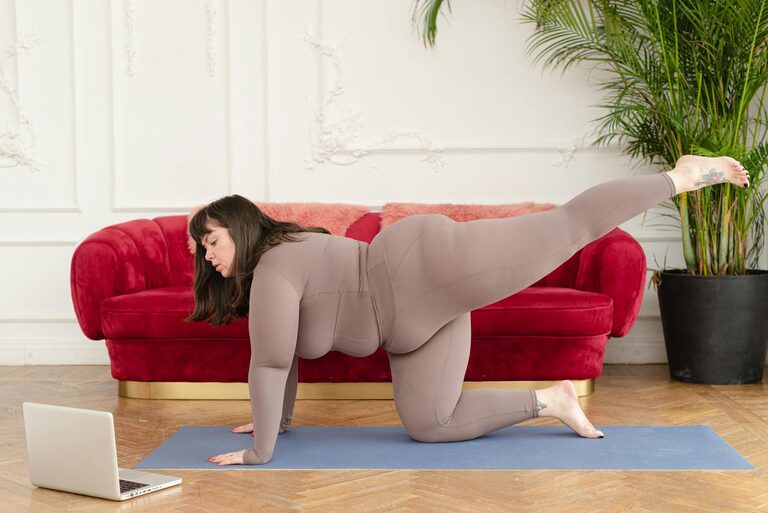Stretching is a simple and effective way to improve your overall health and well-being. Whether you want to increase flexibility, reduce muscle tension, or just feel more relaxed after a long day, stretching can help. The best part? You don’t need any special equipment or a gym membership to get started. This beginner’s guide will walk you through the basics of stretching at home, including tips, techniques, and some easy stretches you can do today.
Why Stretching Matters
Stretching offers many benefits, especially when incorporated into your daily routine. Here are a few reasons why stretching at home is worth your time:
– Improves flexibility: Regular stretching helps your muscles become more pliable, which can enhance your range of motion.
– Reduces muscle tension and stress: Stretching helps relax tight muscles, which can relieve stress and improve your mood.
– Enhances circulation: Stretching increases blood flow to your muscles, supporting recovery and overall health.
– Prevents injuries: Warming up your muscles with gentle stretches can reduce the risk of strains and sprains.
– Supports better posture: Stretching tight muscles around your neck, shoulders, and back can help maintain good posture.
When and How Often Should You Stretch?
You can stretch anytime during the day, but some moments are better than others:
– After waking up: Stretching in the morning helps your body wake up and feel more energized.
– Before or after exercise: Gentle stretching before a workout can warm up your muscles, while stretching afterward helps with recovery.
– During breaks at work: Sitting for long periods can cause stiffness. Gentle stretching breaks boost circulation and reduce discomfort.
– Before bed: Stretching can relax both your body and mind for better sleep.
Aim to stretch for about 10-15 minutes daily or at least 3-4 times a week. Consistency is key to seeing long-term benefits.
Stretching Tips for Beginners
Starting a new routine can be intimidating, but keeping these tips in mind will help you stretch safely and effectively:
- **Warm up first:** Stretch after a light activity, like walking in place for a few minutes, to get your muscles warm.
- **Avoid bouncing:** Stretch slowly and hold each position steadily to avoid muscle strain.
- **Breathe deeply:** Focus on deep, even breaths to help your body relax while stretching.
- **Go to your comfort limit:** Stretch until you feel mild tension, not pain.
- **Hold for 15-30 seconds:** Maintain each stretch that long to allow muscles to lengthen.
- **Stretch both sides:** Remember to stretch equally on both sides of the body.
- **Wear comfortable clothing:** Loose clothes allow freedom of movement.
- **Use a mat or towel:** A soft surface can make stretching more comfortable.
Essential Stretching Exercises to Try at Home
Here are some beginner-friendly stretches targeting various parts of your body. You can do these as a quick routine or spread them throughout your day.
Neck Stretch
Neck stiffness is common, especially if you spend a lot of time at a desk.
– Sit or stand tall.
– Slowly tilt your head to the right, bringing your ear toward your shoulder.
– Hold for 20 seconds, feeling the gentle stretch on the left side of your neck.
– Repeat on the left side.
Shoulder Rolls
A great way to release shoulder tension.
– Stand or sit with your back straight.
– Slowly roll your shoulders forward in a circular motion 10 times.
– Then reverse direction and roll your shoulders backward 10 times.
Chest Opener Stretch
Helps counteract slouching and opens up the chest.
– Stand or kneel.
– Clasp your hands behind your back.
– Straighten your arms and lift your chest while squeezing your shoulder blades together.
– Hold for 20-30 seconds.
Seated Forward Bend
Stretches the lower back and hamstrings.
– Sit on the floor with legs extended straight in front.
– Inhale and lengthen your spine.
– Exhale and hinge at your hips, reaching toward your toes (bend knees slightly if needed).
– Hold for 20-30 seconds.
Cat-Cow Stretch
A gentle spine mobilizer and stress reliever.
– Start on all fours with wrists under shoulders and knees under hips.
– Inhale: arch your back, lifting your belly and head toward the ceiling (Cow pose).
– Exhale: round your back, tuck your chin, and tuck your pelvis (Cat pose).
– Repeat this flow 8-10 times.
Standing Quadriceps Stretch
Stretches the front of your thighs.
– Stand tall, hold onto a chair or wall for balance if needed.
– Bend your right knee, bringing your heel toward your buttocks.
– Grab your ankle with your right hand and gently pull.
– Hold for 20-30 seconds.
– Switch sides.
Child’s Pose
A restful stretch for hips, thighs, and back.
– Kneel on the floor and sit back on your heels.
– Extend your arms forward and lower your chest toward the floor.
– Hold for 30 seconds or as long as feels comfortable.
Creating Your Own Stretching Routine
Once you feel comfortable with these stretches, you can assemble them into a routine suited to your needs. A simple full-body routine could look like this:
- Warm up with shoulder rolls (1-2 minutes)
- Neck stretch (both sides)
- Chest opener stretch
- Cat-Cow stretch (8-10 reps)
- Seated forward bend
- Standing quadriceps stretch (both legs)
- Child’s pose to finish
Try to move slowly and breathe deeply through each stretch, spending about 10-15 seconds to half a minute on each.
Final Thoughts
Stretching at home is a convenient way to improve flexibility, reduce stress, and take care of your body. With just a few minutes a day and no special equipment, you can create a positive habit that supports your health and energy. Remember to listen to your body, stay consistent, and enjoy the calming benefits of stretching. Happy stretching!

